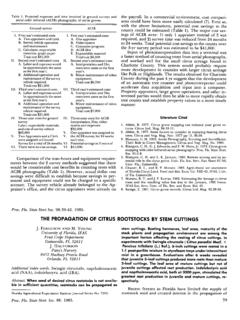Transcription of ISSN-2249-5746 International Journal Of Ayurvedic And ...
1 ISSN-2249-5746 International Journal Of Ayurvedic And Herbal Medicine 3:1 (2013)1095:1100 Journal Homepage HEALTH AND MEDICINAL PROPERTIES OF LEMON (CITRUS LIMONUM) *, Dr. Lalitha Ramaswamy** and Rajendran** INTRODUCTION: Lemon is an important medicinal plant of the family Rutaceae. It is cultivated mainly for its alkaloids, which are having anticancer activities and the antibacterial potential in crude extracts of different parts (viz., leaves, stem, root and flower) of Lemon against clinically significant bacterial strains has been reported (Kawaii et al., 2000). Citrus flavonoids have a large spectrum of biological activity including antibacterial, antifungal, antidiabetic, anticancer and antiviral activities (Burt, 2004 and Ortuno et al.)
2 , 2006). Flavonoids can function as direct antioxidants and free radical scavengers, and have the capacity to modulate enzymatic activities and inhibit cell proliferation (Duthie and Crozier, 2000). In plants, they appear to play a defensive role against invading pathogens, including bacteria, fungi and viruses (Sohn et al., 2004). Flavonoids are generally present in glycosylated forms in plants, and the sugar moiety is an important factor determining their bioavailability. Preparation from peel, flowers and leaves of bitter orange (Citrus aurantium L.) are popularly used in order to minimize central nervous system disorders (Pultrini et al., 2006).The peel of Citrus fruits is a rich source of flavonoid glycosides, coumarins, and volatile oils (Shahnah et al., 2007). Many polymethoxylated flavones have several important bioactivities, which are very rare in other plants (Ahmad et al.
3 , 2006). In addition the fiber of citrus fruit also contains bioactive compounds, such as polyphenols, the most important being vitamin C (or ascorbic acid), and they certainly prevent and cure vitamin C deficiency-the cause of scurvy (Aronson, 2001). SCIENTIFIC CLASSIFICATION: Kingdom Plantae, Angiosperms, Eudicots, Rosids Order Sapindales Family Rutaceae Genus Citrus Species C. limon Binomial name - Citrus limon * Scholar, Department of Nutrition & Dietetics, PSG College of Arts & Science, Coimbatore. ** Associate Professor, Department of Nutrition & Dietetics, PSG College of Arts & Science, Coimbatore. ** Principal, Department of Microbiology, PSG College of Arts & Science, Coimbatore. BOTANICAL DISTRIBUTION: International Journal of Ayurvedic & herbal medicine 3(1) jan . 2013(1095-1100) 1096 Lemon grows on small, thorny trees which reaches a height of 10 to 20 feet.
4 The leaves of the lemon are dark green in colour and they are arranged alternately on the stem. The lemon has a white, fragrant flower with five petals. This particular flower comes from a lemon cultivar called Pink Lemonade . The leaves of this cultivar are variegated and the fruit is striped. Lemons are oval citrus fruits with smooth porous skin. Some fruits have a pointed tip on the bottom of the fruit while other lemons are rounded at the base. Some kinds of lemons are quite larger than other lemon varieties and resemble elongated grapefruits. Lemon has many varieties few of which includes Bush lemon, Eureka, Lisbon, Ponderosa, Variegated Pink, Verna, Villafranca, Yen Ben and Yuzu. The colour range of lemon fruit is from greenish yellow to bright yellow. Lemons look very similar to limes, but lemons tend to be a little larger and are yellow when ripe, where limes are green.
5 GEOGRAPHICAL DISTRIBUTION: The lemon is both a small evergreen tree which is native to AsiaNUTRITIONAL VALUE: as well as tree s oval yellow fruit. Throughout the world, the fruit can be used for culinary and non-culinary purposes. Primarily it is used for its juice through the pulp and zest is also used mainly in cooking and baking. The top producers of lemon include India, Mexico, Argentina, Brazil, Spain, Peoples Republic of China, United States, Turkey, Iran and Italy. Following is the nutritional value of 100 grams of raw lemon without peel Energy 121 kJ (29 kcal) Carbohydrates g Sugars - g Dietary fibre g Fat g Protein g Thiamine (Vit. B1) mg (3%) Riboflavin (Vit. B2) mg (1%) Niacin (Vit. B3) mg (1%) Pantothenic acid (B5) mg (4%) Vitamin B6 mg (6%) Folate (Vit. B9) 11 g (3%) Vitamin C mg (88%) Calcium 26 mg (3%) Iron mg (5%) Magnesium 8 mg (2%) Phosphorus 16 mg (2%) Potassium 138 mg (3%) Zinc mg (1%) International Journal of Ayurvedic & herbal medicine 3(1) jan.
6 2013(1095-1100) 1097 CULINARY USES: Lime is consumed throughout the world in sorbets, beverages, refreshing drinks, pickles, jams, jellies, snacks, candies, sugar boiled confectionaries and culinary and the oil extracted from its peel or skin is extensively used in soft drink concentrates, body oils, cosmetics, hair oils, tooth pastes, toilet and beauty soaps, disinfectants, mouth washes, deodorants and innumerable other products. There are many varieties of lime found all over the world, particularly in the tropical and the Mediterranean climates. HEALTH BENEFITS OF LIME: The health benefits of lime include weight loss, skin care, good digestion, relief from constipation, eye care, and treatment of scurvy, piles, peptic ulcer, respiratory disorders, gout, gums, urinary disorders, etc. The first fruit that comes to our minds when it comes to medicinal uses is perhaps the good old lime.
7 This sour citrus fruit can do what many specialist medicines cannot. Lime, bearing the scientific name Citrus Aurantifolia, is being used for ages for treatment of various ailments. THE BENEFITS AND MEDICINAL USES OF LIME: Scurvy: Lime is so famous as a cure for scurvy, the disease which is caused due to deficiency of vitamin-C and characterized by frequent infections with cough and cold; cracked lips and lip corners; ulcers in tongue and mouth; spongy, swollen and bleeding gums etc. that now a days even a child can tell you that. Since its cause is deficiency of vitamin-C, its remedy is none other than vitamin-C, and lime is blessed with this vitamin. In olden days, soldiers and sailors were given lime to keep safe from scurvy, which was a dreaded disease then. Even now, it is distributed among the workers working in polluting environments like those working in furnaces, painting shops, heat treatments, cement factories, mines etc.
8 To protect them from scurvy. Skin Care: Lime juice and its oil are very beneficial for skin when consumed orally or applied externally. It rejuvenates the skin, keeps it shining, protects it from infections and reduces body odor due to presence of a large amount of vitamin-C and Flavonoids, both of which are class-1 anti oxidants, anti biotic and disinfectants. When applied externally on skin, its acids scrub out the dead cells, cures dandruff, rashes, bruises etc. and gives you a refreshing bath if its juice or oil is mixed into your bathing water. Digestion: Lime has an irresistible scent which waters the mouth and thus aid primary digestion (the digestive saliva floods your mouth even before you taste it). Then the acids in it do the rest. While they break down of the macro molecules of the food, the Flavonoids, the compounds found in the fragrant oils extracted from lime, stimulate the digestive system and increase secretion of digestive juices, bile and acids and also stimulate the peristaltic motion.
9 This is the reason behind having lemon pickle with lunch and dinner is an age old practice in India and some of its neighbouring countries. International Journal of Ayurvedic & herbal medicine 3(1) jan . 2013(1095-1100) 1098 Constipation: Primarily, the ample of acids present in lime helps clear the excretory system by washing and cleaning off the tracts, just like some acids are used to clean floor and toilets. Then the roughage in it is also helpful in easing constipation. But it is mainly due to high acids. An overdose of lime juice with salt also acts as an excellent purgative without any side effects, thereby giving relief in constipation. Peptic Ulcer: In addition to vitamin-C, lime contains special compounds called Flavonoids (Limonoids such as Limonin Glucoside) which have anti oxidant, anti carcinogenic, anti biotic and detoxifying properties which help healing of peptic and oral ulcers.
10 Respiratory Disorders: The oil, containing Flavonoids and certain oils, extracted from lime is extensively used in anti congestive medicines such as balms, vaporizers, inhalers etc. due to presence of Kaempferol. Just scratching the peel of a lime and inhaling it gives immediate relief in congestion and nausea. Eye Care: Vitamin-C again! Its anti oxidant properties protect eyes from aging and macular degeneration. Flavonoids help protect them from infections. Gout: There are two main causes of Gout. While the first reason is accumulation of free radicals in the body; the second is accumulation of toxins, primarily uric acid. Now, limes can help you with both of these. It is a reservoir of anti oxidants & detoxifiers (vitamin-C & Flavonoids) which free radicals as well as detoxify the body. Gums: The root causes of gum problems are deficiency of vitamin-C (Scurvy, which gives bleeding and spongy gums) and microbial growth.






